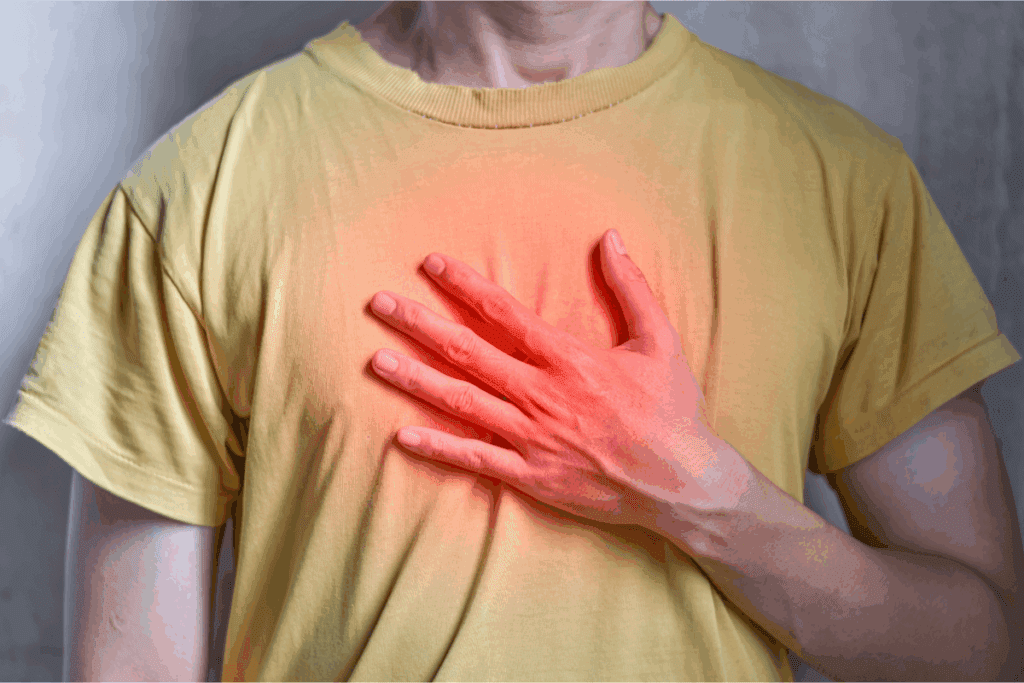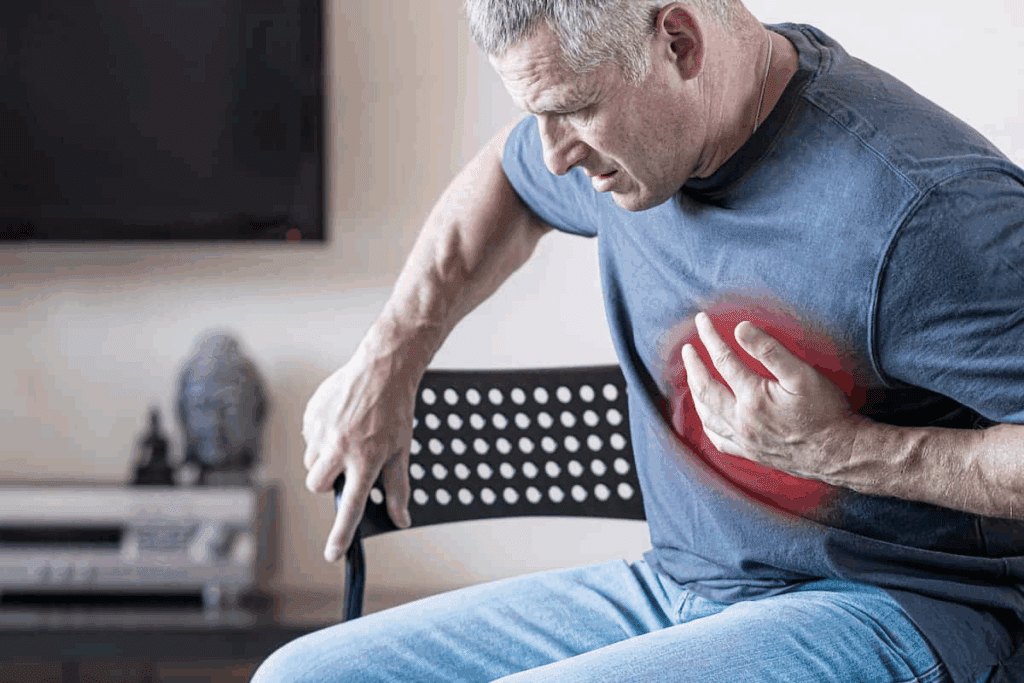Last Updated on November 25, 2025 by Ugurkan Demir

Feeling chest pain and headaches at the same time can be scary and really hurt. At Liv Hospital, Learn how chest discomfort and jaw pain can signal heart problems and when to seek urgent care.
Many health problems, like anxiety, migraines, and heart issues, can make you feel both chest pain and related headaches. Heart problems, like angina or heart attacks, can also cause these symptoms. We aim to give top-notch care to everyone, including international patients.
It’s key to know what these symptoms might mean for your health. Getting medical help is a must to tackle these problems. At Liv Hospital, we use the latest tech and focus on you to make sure you get the best care.

Feeling both chest pain and headache at the same time is a warning sign. It can mean different things, from anxiety to heart problems. It’s key to know what it might mean and to get help fast.
Studies show that chest pain and headache happen together a lot. People with anxiety or panic often feel both. Heart issues can also show up this way.
This pairing is a big reason to pay attention to your health. It’s not just about feeling bad. It could mean something serious is going on.
The mix of chest pain and headache is a big deal. It could mean a serious health problem. Heart attacks, for example, can cause chest pain and headache together.
If you’re feeling tight chest headache or headache tight chest, don’t wait. There are many reasons for these symptoms. A doctor needs to figure out what’s going on.
In short, chest pain and headache together mean you should see a doctor right away. Staying alert to your health can save your life.

Chest pain and headache happening together can be due to many reasons. It’s important to know these reasons to find and treat the cause.
The body’s systems work together in complex ways. The nervous system can send pain signals from one place to another. This is why pain in the chest and head can sometimes feel like it’s coming from the same place.
The cardiovascular system also plays a big role. Heart problems can cause chest pain and, indirectly, headaches. This happens because of changes in blood pressure or oxygen levels.
The trigeminal nerve is key in why chest pain and headaches happen together. It’s involved in facial sensations and can connect with nerves in the chest. This can cause pain in both areas.
Conditions like migraines can also cause both headaches and chest discomfort. This is because of how different nerves work together.
| Condition | Symptoms | Possible Causes |
| Migraine | Headache, chest discomfort | Neurological pathways, trigeminal nerve activation |
| Cardiovascular Disease | Chest pain, headache | Hypertension, reduced blood flow |
| Anxiety/Panic Disorders | Chest tightness, headache | Stress response, hyperventilation |
It’s important to know if the pain is from a body-wide issue or a specific area. Body-wide issues, like infections or autoimmune diseases, can cause many symptoms, including chest pain and headaches.
On the other hand, pain that’s just in the chest or head is usually from a specific problem. For example, musculoskeletal issues in the chest or sinusitis in the head can cause pain in those areas.
Knowing if the pain is from a body-wide issue or a specific area helps doctors figure out what’s wrong and how to treat it.
Chest pain and headache can be scary when they happen together. They are often linked to anxiety and panic disorders. These issues affect millions, causing a lot of distress and trouble in daily life. It’s important to understand how anxiety and panic disorders relate to these symptoms for proper treatment.
Panic attacks can show up in many ways, sometimes feeling like serious health problems. During a panic attack, people might feel chest pain or discomfort. This is because of the body’s “fight or flight” response.
This response can cause a fast heartbeat, palpitations, and tightness in the chest. Headaches can also happen due to tension and stress. A study says, “Panic attacks can cause a range of physical symptoms, including chest pain and headache, due to the intense fear or discomfort experienced during an episode.”
“The physical symptoms of a panic attack can be so severe that they lead individuals to seek emergency medical care, fearing a heart attack or other serious condition.”
The physical symptoms of panic attacks can be very scary. They often come with a strong feeling of fear or anxiety. It’s important to know that these symptoms are usually not signs of a serious condition when they happen with panic attacks.
Pain and anxiety are connected in a complex way. Anxiety can make pain feel worse, and chronic pain can make anxiety higher. This cycle is hard to break, but it’s key to treat both the physical symptoms and the anxiety.
Breaking this cycle requires a treatment plan that covers both physical symptoms and anxiety. Cognitive-behavioral therapy (CBT) and relaxation techniques can help manage this cycle.
It can be hard to tell if chest pain and headache are from anxiety or a serious medical issue, like a heart attack. It’s very important to get medical help right away if you’re not sure about your symptoms. Doctors use tests, patient history, and clinical evaluation to figure out what’s causing the symptoms. Knowing the signs of anxiety-related chest pain and headache can help make this distinction.
By recognizing the signs of anxiety and panic disorders, people can get the right care. This improves their life quality and lowers the risk of problems from untreated anxiety and panic disorders.
We look at the heart problems that cause both chest pain and headache. These diseases are big health threats worldwide. Knowing their signs is key to catching them early.
A heart attack happens when the heart doesn’t get enough blood. This causes damage to the heart muscle. The main sign is chest pain or discomfort, like a tight feeling.
Some people might also get a headache with chest pain. This can happen if the heart attack is severe or if they have high blood pressure.
It’s very important to know the signs of a heart attack. This way, we can get help fast.
Hypertension, or high blood pressure, is a big risk for heart disease. It can hurt both the heart and the brain. High blood pressure can cause chest pain and headaches.
Knowing how high blood pressure affects both systems helps us manage it better. This can lower the risk of serious problems like heart attacks and strokes.
Aortic dissection is a serious condition where the aorta tears. This allows blood to leak between the layers of the aorta. It can cause severe chest pain and headaches.
Aortic dissection is a medical emergency. We need to act fast to save lives.
| Condition | Primary Symptoms | Associated Risks |
| Heart Attack | Chest pain, discomfort | Cardiac damage, arrhythmias |
| Hypertension | Chest pain, headache | Heart disease, stroke, kidney disease |
| Aortic Dissection | Severe chest pain, tearing sensation | Organ failure, death if untreated |
Learning about the link between migraines and chest pain helps us understand this tough condition better. Migraines are more than just headaches. They are a complex brain disorder with many symptoms.
Migraines happen when blood vessels expand and pain chemicals are released. This leads to migraine pain, along with nausea and light sensitivity.
The pathophysiology of migraines involves genetics, environment, and brain factors. Knowing these helps manage migraine symptoms better.
In some cases, migraines can cause chest discomfort or pain. This is scary for those who experience it. It’s thought to be linked to the same brain pathways as migraine headaches.
Studies show that migraines and chest pain share common brain mechanisms. These affect both the brain and the heart.
It’s important to know if chest pain is from a migraine or something else. Migraine chest pain usually comes with other migraine symptoms like headaches and aura.
Understanding the link between migraines and chest discomfort helps doctors treat it better. This improves life for those with this complex condition.
Headache and chest heaviness can signal serious autoimmune conditions. These diseases happen when the body attacks its own tissues. This can lead to various symptoms, depending on the disease and affected areas.
Systemic Lupus Erythematosus (SLE), or lupus, is a classic autoimmune disease. It can cause headaches and chest heaviness. Lupus can affect many parts of the body, including the nervous system, heart, and lungs.
Common symptoms of lupus include:
Other autoimmune diseases like rheumatoid arthritis, scleroderma, and mixed connective tissue disease can also cause these symptoms. These conditions are linked by inflammation. This inflammation can harm various parts of the body, including the heart and nervous system.
| Disease | Primary Symptoms | Potential Complications |
| Lupus | Joint pain, skin rashes, headaches | Kidney damage, cardiovascular disease |
| Rheumatoid Arthritis | Joint pain and swelling, fatigue | Cardiovascular disease, lung disease |
| Scleroderma | Skin thickening, joint pain | Pulmonary hypertension, kidney failure |
Diagnosing these diseases involves clinical evaluation, lab tests, and sometimes imaging studies. Blood tests can find specific autoantibodies linked to different diseases.
Diagnostic tests may include:
It’s important to understand the connection between autoimmune diseases and symptoms like headaches and chest heaviness. This knowledge helps in accurate diagnosis and effective treatment. By recognizing these conditions, healthcare providers can offer better care and improve patient outcomes.
When respiratory triggers cause chest tightness and head pressure, it’s key to find the root cause. Respiratory issues can greatly affect our health, showing up in different symptoms. These symptoms might seem unrelated at first.
A pulmonary embolism is a serious issue where a blood clot blocks a lung’s blood vessel. This can lead to chest pain and trouble breathing. Knowing the warning signs is vital for quick medical help.
Respiratory infections, like the flu or pneumonia, can cause chest pain and head pressure. These infections can cause inflammation and congestion. This affects breathing and comfort.
Common symptoms include:
Asthma is a chronic condition that affects the airways. It causes breathing problems, chest tightness, and sometimes headaches. Managing asthma well is important to control symptoms.
| Asthma Symptoms | Management Strategies |
| Wheezing and coughing | Using inhalers as prescribed |
| Shortness of breath | Avoiding triggers like allergens and smoke |
| Chest tightness | Monitoring lung function with a peak flow meter |
Chest pain and headache can feel different for men and women. Women often show symptoms in ways that are not typical. This is important for doctors to know, as it helps with diagnosis and treatment.
Women tend to have atypical presentation patterns of chest pain and headache. They might feel pain in places like the back, neck, or jaw. Their headaches are often not as severe as what men experience.
Women’s symptoms can be harder to pinpoint because they are more spread out. For example, a woman might feel sharp, stabbing chest pain, not the usual pressure or heaviness men get.
| Symptom | Typical Presentation | Atypical Presentation in Women |
| Chest Pain | Pressure or heaviness | Sharp, stabbing pain or discomfort in other areas like the back or jaw |
| Headache | Severe, throbbing | Mild to moderate, with other symptoms like nausea or sensitivity to light |
Hormonal fluctuations can change how women feel chest pain and headaches. Changes during the menstrual cycle, pregnancy, and menopause can affect symptoms.
Studies show that hormones play a role in how women’s symptoms vary. Knowing this helps doctors give better care.
Women’s symptoms are often misdiagnosed or not diagnosed at all. This is because of how symptoms are presented and biases in medical thinking.
Doctors need to understand these differences to make sure women get the right diagnosis and treatment for their symptoms.
When you feel pain on the left side of your chest, a headache, and fatigue, it’s important to know why. This mix of symptoms can be scary and might mean you have a health problem.
The pain on the left side of your chest can come from your heart or other parts of your body. Cardiac origins include heart problems like angina or a heart attack. Non-cardiac causes might be muscle or stomach issues.
It’s key to figure out the cause with a doctor’s help. If you feel pain that spreads, have trouble breathing, or feel dizzy, it could be heart-related.
Feeling pain in your upper back with left-sided chest pain and headache is a big warning sign. It might mean you have an aortic dissection, a serious tear in your aorta.
Upper back pain can also mean muscle strain or other non-heart problems. But with other symptoms, it’s important to get checked out to make sure you’re okay.
Fatigue is often ignored but is a big warning sign with chest pain and headache. Feeling very tired can mean heart disease, anemia, or chronic fatigue syndrome.
With left-sided chest pain and headache, fatigue means your body is stressed or has a problem affecting many systems.
We stress the need to see a doctor if these symptoms don’t go away or get worse. A doctor can find out what’s wrong and help you get better.
At Liv Hospital, we use a team effort to tackle chest pain and headaches. Our care starts with a detailed medical check-up.
We begin by looking at your medical history and doing a physical exam. We also run tests like ECGs and blood work. These steps help us find out what might be wrong.
For tougher cases, we use top-notch diagnostic tools. This includes CT scans or MRI to see the heart and brain up close.
Our commitment to using the latest technology ensures accurate diagnoses and effective treatment plans.
Our treatment plans are made just for you. Our team works together to offer care that might include medicine, lifestyle changes, or surgery.
Our goal is to provide patient-centered care that addresses the unique needs of each individual.
We combine medical checks, advanced tests, and team care to give our patients the best healthcare.
Knowing when to go to the emergency room is key to avoiding serious health issues. It’s important to recognize the signs of a medical emergency. Quick action can greatly improve health outcomes.
At Liv Hospital, we stress the need to know when to seek immediate medical help. If you have severe chest pain and headache, or trouble breathing, get help right away.
We are dedicated to providing fast, fair, and complete care. We urge everyone to take care of their health and seek medical help when needed. Being informed and watchful helps you manage your health better and make smart choices about medical care.
Chest pain and headache can come from many sources. These include anxiety, migraines, and heart problems. Knowing the causes helps you get medical help quickly.
It’s not rare to have both chest pain and headache. They might signal a serious health issue. If you have these symptoms, see a doctor right away.
Yes, anxiety can lead to chest pain and headaches. Panic attacks often affect the chest and head, making pain worse.
Heart issues like heart attacks, high blood pressure, and aortic dissections can cause these symptoms. Knowing the signs is key to getting help fast.
Yes, migraines can lead to chest pain. It’s important to recognize this to manage the pain properly.
Diseases like lupus can cause headaches and chest pain. Knowing how to diagnose and treat these symptoms is important.
Issues like lung clots, infections, and asthma can cause tightness in the chest and headaches. Knowing the signs is key to getting the right care.
Yes, men and women experience chest pain and headaches differently. Women often have atypical symptoms. Understanding these differences is important for proper care.
Left chest pain, headaches, and fatigue can mean different things. They might be related to the heart or other issues. Recognizing these symptoms is important for getting help.
Liv Hospital uses detailed medical checks, advanced tests, and team care for chest pain and headaches. We aim to provide complete care.
If you have severe or ongoing chest pain and headaches, get emergency help. These signs can mean a serious problem.
Knowing how chest pain and headaches are connected is key to finding and treating the cause.
Yes, chest pain can be heart-related. Understanding the link between headaches and heart pain is important for the right treatment.
Subscribe to our e-newsletter to stay informed about the latest innovations in the world of health and exclusive offers!